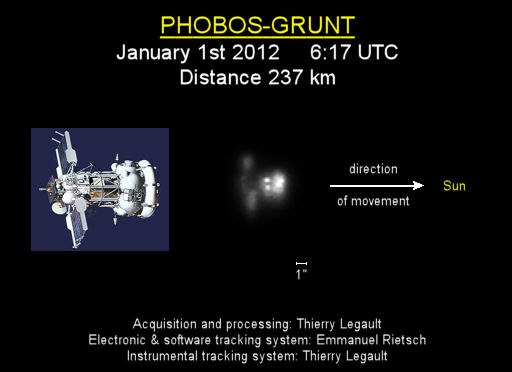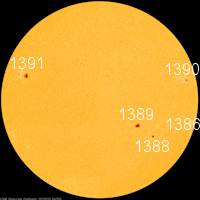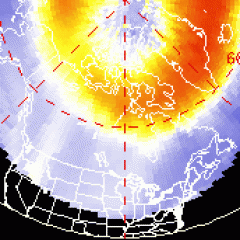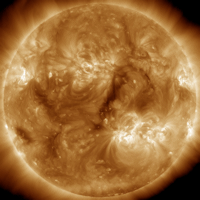~1~5~11~ Space Weather Update~ Beautiful Explosion~ [1]
BEAUTIFUL EXPLOSION: A magnetic filament in the sun's northern hemisphere erupted today, Jan. 5th, at approximately 1300 UT. The beautiful explosion [2] hurled a CME in the general direction of Earth, but the cloud might sail north of our planet with little to no impact. Stay tuned for updates.
DOOMED MARS PROBE PHOTOGRAPHED: Russia's Mars probe, Phobos-Grunt [3], has been stranded in Earth orbit since a main engine failure in early November. The spacecraft is now sinking back into Earth's atmosphere, with re-entry expected in mid-January. "On New Year's Day, I traveled to the French Riviera (850km from home) to record Phobos-Grunt's last passage over France," says astrophotographer Thierry Legault. This is the picture he took through a 14-inch telescope:
"It appears that the satellite is moving backwards with its solar panels deployed but not receiving the sunlight," notes Legault. "This may explain why Phobos-Grunt had no energy to communicate with Earth." An 80-second video [5] shows the probe soaring almost directly above Legault's observing site on the Plateau de Calern. "At the scale of the video the satellite would cross your screen in about 1/30s," he says.
While a telescope is required to see the outlines of the spacecraft, the human eye alone is sufficient to see Phobos-Grunt as a speck of light in the night sky. On high passes, it glows almost as brightly as a first magnitude star. Check SpaceWeather's online Satellite Tracker [6] or your smartphone [7] for flyby times.
QUADRANTID METEOR UPDATE: Yesterday, Jan. 4th, Earth passed through a stream of debris from shattered comet 2003 EH1. The encounter produced a strong display of Quadrantid [8] meteors over the Atlantic side of our planet, as many as 80 per hour [9] according to the International Meteor Organization. Meteor rates peaked hours later and remained high hours longer than forecasters expected, which shows that we still have a lot to learn about the debris stream of 2003 EH1.
Zack Clothier of Thurman, New York, photographed this Quadrantid streaking over a lake in the Adirondacks:
"Temperatures were below zero here in the Adirondacks, but the sky put on such a show I stayed and watched it for four hours," says Clothier. "I counted nearly 60 meteors during that time, including this one shooting through the Milky Way. It was a wonderful night to be out under the stars, and one I definitely won't forget anytime soon!"
NASA's All-Sky Fireball Network recorded 20 fireballs [11] during the shower's peak. Data from multiple cameras allowed the orbits of the meteoroids to be calculated, and they are shown here in a diagram of the inner solar system:
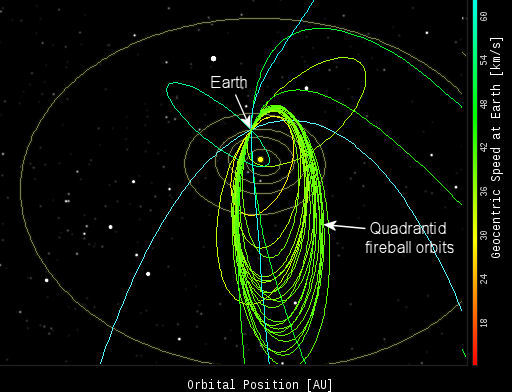
The green orbits are a good match for the orbit of the parent comet fragment 2003 EH1. Colors in the diagram correspond to velocity. The Quadrantids hit Earth's atmosphere traveling between 38 and 42 km/s (85,000 and 94,000 mph).

![]()
Solar wind
speed: 369.6 km/sec
density: 6.9 protons/cm3
explanation [12] | more data [13]
Updated: Today at 0025 UT
![]()
X-ray Solar Flares
6-hr max: B8 2040 UT Jan05
24-hr: C2 1238 UT Jan05
explanation [14] | more data [15]
Updated: Today at: 2359 UT
![]()
![]()
![]()
Daily Sun: 05 Jan 12
![]()
![]()
All of the sunspots on the Earthside of the sun are magnetically simple and quiet. Credit: SDO/HMI
![]()
![]()
![]()
Sunspot number: 101
What is the sunspot number? [17]
Updated 04 Jan 2012
Spotless Days
Current Stretch: 0 days
2012 total: 0 days (0%)
2011 total: 2 days (<1%)
2010 total: 51 days (14%)
2009 total: 260 days (71%)
Since 2004: 821 days
Typical Solar Min: 486 days
Updated 04 Jan 2012
The Radio Sun
10.7 cm flux: 136 sfu
explanation [18] | more data [19]
Updated 04 Jan 2012
![]()
![]()
![]()
Current Auroral Oval:
Switch to: Europe, USA, New Zealand, Antarctica
Credit: NOAA/POES
![]()
![]()
![]()
Planetary K-index
Now: Kp= 1 quiet
24-hr max: Kp= 3 quiet
explanation [21] | more data [22]
![]()
Interplanetary Mag. Field
Btotal: 8.7 nT
Bz: 2.0 nT north
explanation [23] | more data [24]
Updated: Today at 0025 UT
![]()
![]()
![]()
Coronal Holes: 05 Jan 12
![]()
![]()
There are no large coronal holes on the Earthside of the sun. Credit: SDO/AIA.
![]()
![]()
![]() SPACE WEATHER
SPACE WEATHER
NOAA Forecasts

![]()
![]()
Updated at: 2012 Jan 05 2200 UTC
![]()
![]()
![]()
![]()
Geomagnetic Storms:
Probabilities for significant disturbances in Earth's magnetic field are given for three activity levels: active [26], minor storm [26], severe storm [26]
![]()
Updated at: 2012 Jan 05 2200 UTC
![]()
Mid-latitudes
![]()
High latitudes
Category:
- Ground Crew Updates [27]
